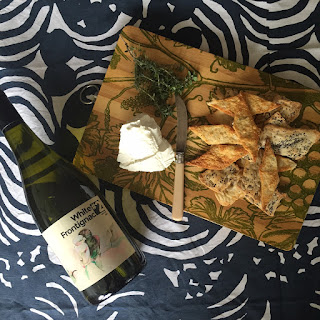It's obviously been the burning question, plaguing you night and day, causing you to lose sleep, etc... Well, look no further than this handy little post to answer your question, restore your sleep and hopefully give you an edge come the next trivia night you're involved in.
It's really a two parter.
Firstly, and in my opinion, one of the most important questions in life to date...
WHAT IS WINE?
 Well, a super brief 101 lesson...WINE is the fermented juice of grapes (or other fruits and grains). The juice can be treated in a variety of ways, yeasts added (or natural yeasts relied on to kick off the fermenting), skins left on, or removed, the juice aged in barrels made of oak, or in glass bottles, or steel vats, etc. Essentially, grape based wine is a delicious alcoholic beverage which can come in red, white, rose, or sparkling varieties. There are many different grape varietals all with their own distinct flavour profiles. Wine has been around for thousands of years...archeologists have unearthed jars of wine as old as 9000 years, but I think it's pretty safe to say that people were enjoying the heady effects of wine (or some kind of equivalent) since the dawn of man.
Well, a super brief 101 lesson...WINE is the fermented juice of grapes (or other fruits and grains). The juice can be treated in a variety of ways, yeasts added (or natural yeasts relied on to kick off the fermenting), skins left on, or removed, the juice aged in barrels made of oak, or in glass bottles, or steel vats, etc. Essentially, grape based wine is a delicious alcoholic beverage which can come in red, white, rose, or sparkling varieties. There are many different grape varietals all with their own distinct flavour profiles. Wine has been around for thousands of years...archeologists have unearthed jars of wine as old as 9000 years, but I think it's pretty safe to say that people were enjoying the heady effects of wine (or some kind of equivalent) since the dawn of man. Secondly, and also extremely important...
WHAT DOES ORGANIC MEAN (in reference to wine, of course)?
In terms of farming, ORGANIC is a form of agriculture that relies only on the use of natural fertilizers, herbicides and pesticides. Often organic farming is very mindful of the environment, trying to farm in ways which minimise impact on the land, this can include crop rotation, companion planting, etc. No artificial chemicals, no genetically modified organisms, and in the case of animals, no antibiotics or artificial growth stimulating hormones, are used in the production of organically farmed plants or animals.
 |
| Rainbows over the Rosnay Organic Vineyards. |
Organic farming practices are as old as agriculture itself, and thankfully have seen a resurgence of popularity in more recent times. Many of the chemicals that have been used in the past, and even today, have a dubious record when it comes to potential damage to the environment, animals and people. I figure if there is a way to farm without them, why not?!
WHAT IS ORGANIC WINE?
Well, putting the two pieces of information above together, pretty clearly spells out that ORGANIC WINE is wine that is created using only grapes (or other additives) which are farmed/produced organically. This means that if milk products are added, or yeasts added they must be organic as well.
How about those PRESERVATIVES?
It must be remembered that organic wine is not always preservative free wine. Sulfur dioxide, and any other preservatives in their purest form are organic too! So, if you are looking to avoid added preservatives in your vino you will need to look beyond the organic label alone. {I'll do a post on preservative free wines soon, but for now don't want to overload the information receivers. If you're keen for more information immediately, check out our website.}
Another really interesting thing about organic vineyards and wine makers (and indeed any organic producer), is that wine can be produced according to organic philosophies and practices without being Certified Organic. Organic certification is quite expensive, and incredibly prescriptive. Farms with organic certification must undergo extensive and testing, and jump through loads of hoops to make sure they keep their organic status. There can be no hint that there are non organic chemicals anywhere near their farms, and they have to have been farming organically for several years before even being considered for certification. Many farms, and wine makers, are happy to forgo the certification process, and just go about their organic farming business, they are permitted (in Australia) to label their wine as being produced according to organic farming philosophies, but they cannot say they have certification, or use the Australian Certified Organic logo. In many ways this can be a tricky business for wineries, as the logo and certification is often the first thing that consumers look for and can trust. You can have a read about ACO on their website for more details about the process of certification.

As an example, Freehand Wines, a lovely little wine producer in Western Australia, produces natural wine according to organic and biodynamic philosophies, but does not have certification. I've met the people behind the Freehand Label - Matt Eastwell, and Danni, his partner in wine making and life, they are passionate about farming without the use of man-made chemicals and additives. Their wine is absolutely organic and biodynamic. No certification necessary!
The message is:
1. Not having organic certification, does not necessarily mean that wine is not organic, check out Freehand as an example.
2. Organic wine is not necessarily Preservative Free wine, nor is it always Vegan friendly.
Happy drinking!







